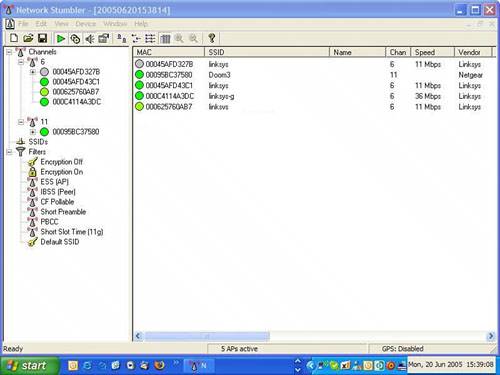Absolute Beginners Guide to Security, Spam, Spyware & Viruses
| If it's easy to access a wireless network, who's snooping? Well, there are a few types of interlopers. Generically, I call them wireless network snoops , but they come in three basic varieties. Wardrivers
Wi-Fi is such a huge phenomenon that all you have to do is drive down a city street with a Wi-Fi enabled laptop to pick up dozens of open Wi-Fi networks. Approximately 40%60% of all wireless routers are unprotected by security measures. These wireless networks make geeks curious . They can't resist probing them, poking them, and sampling them a bit. These geeks are kind of like kids around a bowl of cake icing. Most just sneakily sample a little bit of the wireless offering and move on. The problem is that more nefarious geeks take it too far. These are the people that when they were kids would steal the icing bowl, lick it clean, and wear it as a hat. They are the ones you should be concerned about. The practice of probing wireless networks is called wardriving . All wardrivers need is a car, a Wi-Fi laptop, a snooping program downloaded from the Internet (see Figure 6.3), and optionally an upgrade antenna. Sometimes these are made out of cylindrical potato chip cans. Figure 6.3. Network Stumbler is a free program that can be used to electronically sniff out Wi-Fi networks.
Wardrivers also sometimes use Global Positioning System (GPS) receivers to register the exact geographical location of an open Wi-Fi network. These coordinates are cataloged and sometimes published to the Web so others can locate the open networks when they need to connect to the Internet. How Wardrivers Operate
Want to see what wardrivers see? If you live in a well- populated urban area, there are probably at least half a dozen Wi-Fi networks detectable right where you sit. If you live in an apartment building, there might be dozens. I once opened my laptop in an apartment in one of those clusters of high-rise apartments and detected 23 Wi-Fi networks. Now, I am not advocating that you engage in wardriving practices. Trespassing on networks you do not own is illegal in Canada and the United States and likely other jurisdictions. However, I want you to know how easy it is to do it. Here's the fail safe: If you don't actually connect to the wireless network, you're not doing anything wrong. That said, here's how to peek at the networks near you:
Figure 6.4. In the Wireless Network Connection Status box, click View Wireless Networks to see what Wi-Fi networks are available to connect to.
Tip
Figure 6.5. The Wireless Network Connection box contains a list of the Wi-Fi networks detected by your computer that you might be able to access.
Figure 6.6. A lock next to the Wi-Fi entry means the router has wireless security measures turned on.
Bandwidth Bandits
The most likely damage you can expect to your wireless home network is not really damage, but more of an inconvenience: People will steal your bandwidth.
Caution
Bandwidth is your Internet connection's capacity to carry data. In plumbing terms, bandwidth would be the diameter of the pipe that carries water through your house. This is not to be confused with bumwidth, which is the mathematical capacity for a plumber's pants to ride down based on the girth of his belly. If you notice a slowdown on your Internet connection, it could be because a bandwidth bandit is accessing your network and sharing your bandwidth. Because wireless connections are possible up to 300 feet from the Wi-Fi router, it's easy for someone outside your home to log on to your Wi-Fi connection, access the Internet, and get her email or surf the Web without your permission. By doing this, she is stealing your bandwidth.
Caution
If you live above or very close to a coffee joint, bus station, or any place where people with laptops might gather, I can guarantee that the local bandwidth bandits love you and are happily using your open Wi-Fi Internet connection. Long ago, before I wrote fun books like this, I commuted to work on a train into Toronto. (I also put pants on before noon and shaved daily.) When the train stopped at a station on the way, I'd pick up a local Wi-Fi signal for a minute or so. This was long enough to download my email. Many of the people around me did the same with their laptops. If the person who owned the connection was trying to surf the Internet when the train pulled in, he'd see his Internet service slow drastically until all us bandwidth bandits disappeared out of range as the train pulled out of the station again.
Wireless Hackers
Perhaps the most insidious wireless network snoopsbesides pantless book writersare criminally minded people who are out to hack onto your network and steal your banking access information, identity, or other valuable data on your home network. Although these people are rare, they are also the most dangerous type of wireless network snoop. If you work for a big corporation, these people might also be able to get onto your wireless network and access a computer that has security access to your company's network. If you have access to a virtual private network (VPN)a secure connection which you use to access your company's servers from homeyou are at risk. A VPN uses the public Internet to tunnel like an electronic gopher across the public Internet into the company's network. The data that runs through this digital tunnel is protected from snoops because the data is scrambled. However, a wireless snoop can make his way onto your computer, access the open end of this electronic tunnel, and march down it into your company's network. |

